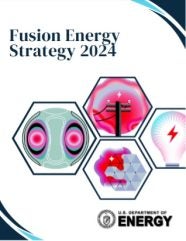
The US Department of Energy (DOE) has marked the two-year anniversary of the Administration’s launch of the Bold Decadal Vision for Commercial Fusion Energy with the release of the DOE Fusion Energy Strategy 2024.
DOE launched a Department-wide initiative to develop a strategy for accelerating the viability of commercial fusion energy in partnership with the private sector. The 27-page Fusion Energy Strategy 2024 is organised around three pillars: closing the science and technology (S&T) gaps to a commercially relevant fusion pilot plant; preparing the path to sustainable, equitable commercial fusion deployment; and building and leveraging external partnerships.
“With today’s announcements, DOE has shown once again that we are ambitiously implementing our US Bold Decadal Vision for Commercial Fusion Energy,” said DOE Deputy Secretary David Turk. “We will leverage the opportunities enabled by our world-leading public and private fusion leadership, including humanity’s first-ever demonstration of fusion ignition at our National Ignition Facility as well as major new advances in technologies such as high-temperature superconductors, advanced materials, and artificial intelligence to accelerate fusion energy. The development of fusion energy as a clean, safe, abundant energy source has become a global race, and the US will stay in the lead.”
DOE also announced a $180m funding opportunity for Fusion Innovative Research Engine (FIRE) Collaboratives. The FIRE Collaboratives are aimed at supporting the further creation of a fusion innovation ecosystem by forming teams that will have a collective goal of bridging the Department’s Fusion Energy Sciences (FES) programme’s foundational and enabling science research with the needs of the growing fusion industry, including the technology roadmaps of the awardees of the Milestone-Based Fusion Development Programme. These Collaboratives are envisioned as dynamic hubs of innovation to help bolster US-based manufacturing and supply chains, driving advancements in fusion energy research in collaboration with both public and private entities.
The FIRE Collaboratives Funding Opportunity Announcement, sponsored by the FES programme within the Department’s Office of Science, can be found on the Funding Opportunities webpage and is open to accredited US colleges and universities, national laboratories, non-profits, and private companies. Outyear funding for the FIRE Collaboratives is subject to congressional appropriations.
Along with the Fusion Energy Strategy 2024, DOE also launched and a new FES vision entitled Building Bridges. These documents are closely coordinated and will guide future DOE investments in fusion energy research, development, and demonstration. As part of the Building Bridges vision, FES will develop a national fusion S&T roadmap to address the “how” and “when” of closing critical S&T gaps to commercially relevant fusion pilot plants.
The Fusion Energy Strategy 2024 has three pillars:
- Resolving the scientific and technological gaps to a fusion pilot plant. To accelerate progress in research and development, we’re aligning fusion-related efforts across government, academia, public, and private sectors. We’re building a roadmap that outlines the “how” and “when” to close critical gaps, and listening to our communities’ concerns with fusion energy so we can address them early.
- Paving the way for commercial fusion deployment. To prepare for fusion as a viable clean energy source, we must consider broader activities and specific commercialization risks now, so that they can be tackled while we resolve the remaining science and technology challenges. A multidisciplinary team across DOE is already working to expand capital flow via public-private partnerships, ensure availability of fuel supplies, consider an appropriate international fusion-non-proliferation framework, and enable effective waste-management pathways.
- Cultivating and expanding partnerships. Broad partnerships are needed and have the power to turn DOE science and engineering research into real, commercial solutions. From federal and state agencies, to academic, private, nonprofit, and international partners, working together will encourage innovation and enable faster progress in support of the development of a competitive US fusion industry.


